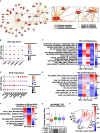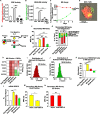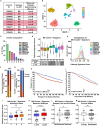Identification of a novel ER-NFĸB-driven stem-like cell population associated with relapse of ER+ breast tumors
- PMID: 36482488
- PMCID: PMC9733334
- DOI: 10.1186/s13058-022-01585-1
Identification of a novel ER-NFĸB-driven stem-like cell population associated with relapse of ER+ breast tumors
Abstract
Background: Up to 40% of patients with estrogen receptor-positive (ER+) breast cancer experience relapse. This can be attributed to breast cancer stem cells (BCSCs), which are known to be involved in therapy resistance, relapse, and metastasis. Therefore, there is an urgent need to identify genes/pathways that drive stem-like cell properties in ER+ breast tumors.
Methods: Using single-cell RNA sequencing and various bioinformatics approaches, we identified a unique stem-like population and established its clinical relevance. With follow-up studies, we validated our bioinformatics findings and confirmed the role of ER and NFĸB in the promotion of stem-like properties in breast cancer cell lines and patient-derived models.
Results: We identified a novel quiescent stem-like cell population that is driven by ER and NFĸB in multiple ER+ breast cancer models. Moreover, we found that a gene signature derived from this stem-like population is expressed in primary ER+ breast tumors, endocrine therapy-resistant and metastatic cell populations and predictive of poor patient outcome.
Conclusions: These findings indicate a novel role for ER and NFĸB crosstalk in BCSCs biology and understanding the mechanism by which these pathways promote stem properties can be exploited to improve outcomes for ER+ breast cancer patients at risk of relapse.
Keywords: Breast cancer; Estrogen receptor; NFĸB; Single-cell RNA sequencing; Stem cells.
© 2022. The Author(s).
Conflict of interest statement
The authors declare they have no competing interests.
Figures







Similar articles
-
Selective pressure of endocrine therapy activates the integrated stress response through NFκB signaling in a subpopulation of ER positive breast cancer cells.Breast Cancer Res. 2022 Mar 9;24(1):19. doi: 10.1186/s13058-022-01515-1. Breast Cancer Res. 2022. PMID: 35264224 Free PMC article.
-
Cancer stem-like properties of hormonal therapy-resistant breast cancer cells.Breast Cancer. 2019 Jul;26(4):459-470. doi: 10.1007/s12282-018-00944-1. Epub 2019 Jan 4. Breast Cancer. 2019. PMID: 30610551
-
The forkhead transcription factor FOXM1 promotes endocrine resistance and invasiveness in estrogen receptor-positive breast cancer by expansion of stem-like cancer cells.Breast Cancer Res. 2014 Sep 12;16(5):436. doi: 10.1186/s13058-014-0436-4. Breast Cancer Res. 2014. PMID: 25213081 Free PMC article.
-
Prognostic and Predictive Biomarkers of Endocrine Responsiveness for Estrogen Receptor Positive Breast Cancer.Adv Exp Med Biol. 2016;882:125-54. doi: 10.1007/978-3-319-22909-6_5. Adv Exp Med Biol. 2016. PMID: 26987533 Review.
-
Causal Therapy of Breast Cancer Irrelevant of Age, Tumor Stage and ER-Status: Stimulation of Estrogen Signaling Coupled With Breast Conserving Surgery.Recent Pat Anticancer Drug Discov. 2016;11(3):254-66. doi: 10.2174/1574892811666160415160211. Recent Pat Anticancer Drug Discov. 2016. PMID: 27087654 Free PMC article. Review.
Cited by
-
RUNX3 exerts tumor-suppressive role through inhibiting EXOSC4 expression.Funct Integr Genomics. 2024 May 17;24(3):103. doi: 10.1007/s10142-024-01363-6. Funct Integr Genomics. 2024. PMID: 38913281
-
Study on the mechanism of heterogeneous tumor-associated macrophages in three subtypes of breast cancer through the integration of single-cell RNA sequencing and in vitro experiments.Mol Biol Rep. 2024 Jun 1;51(1):720. doi: 10.1007/s11033-024-09665-5. Mol Biol Rep. 2024. PMID: 38824268
-
Repurposing of approved drugs for targeting CDK4/6 and aromatase protein using molecular docking and molecular dynamics studies.PLoS One. 2023 Sep 8;18(9):e0291256. doi: 10.1371/journal.pone.0291256. eCollection 2023. PLoS One. 2023. PMID: 37682937 Free PMC article.
References
MeSH terms
Substances
Grants and funding
LinkOut - more resources
Full Text Sources
Medical

